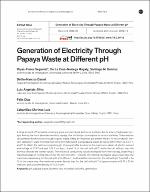Generation of Electricity Through Papaya Waste at Different pH

View/
Author(s)
Rojas-Flores, Segundo
De La Cruz-Noriega, Magaly
Benites, Santiago M.
Delfín-Narciso, Daniel
Angelats-Silva, Luis
Díaz, Felix
Cabanillas-Chirinos, Luis
Date
2022Metadata
Show full item recordPublisher
Environmental Research, Engineering and Management
Journal
Journal of Environmental Research, Engineering and Management
Abstract
A large amount of fruit waste is being a great environmental and social problem due to a lack of adequate storage. Among the most abundant waste is papaya, due to its high consumption in various varieties. These wastes can generate bioelectricity through organic waste, being an important parameter the pH. In this research, lowcost laboratory-scale microbial fuel cells were fabricated, using papaya waste as fuel at different pH (4, 5.73, 7, and 9) to obtain the optimum operating pH. It was possible to observe the maximum values of electric current and voltage of 17.97 mA and 1.02 V on days 16 and 14, in the cell with pH 7; while the cell with pH was the one that showed the lowest values. The electrical conductivity values increased from the first day, observing a maximum peak of 172.50 mS/cm for the cell with pH 7. However, the internal resistance values were low, the maximum value being for the cell with pH 4 (234.61 ± 34 Ω) and the minimum for the cell with pH 7 (46.543 ± 3.6Ω). In the same way, the maximum power density was for the cell with pH 7 of approximately 645.74 ± 33.64 mW/cm2 and a current density of 5.42 A/cm2
.
Type
info:eu-repo/semantics/article
Rights
info:eu-repo/semantics/openAccess
Language
eng
Collections
- Ingeniería Ambiental [85]

